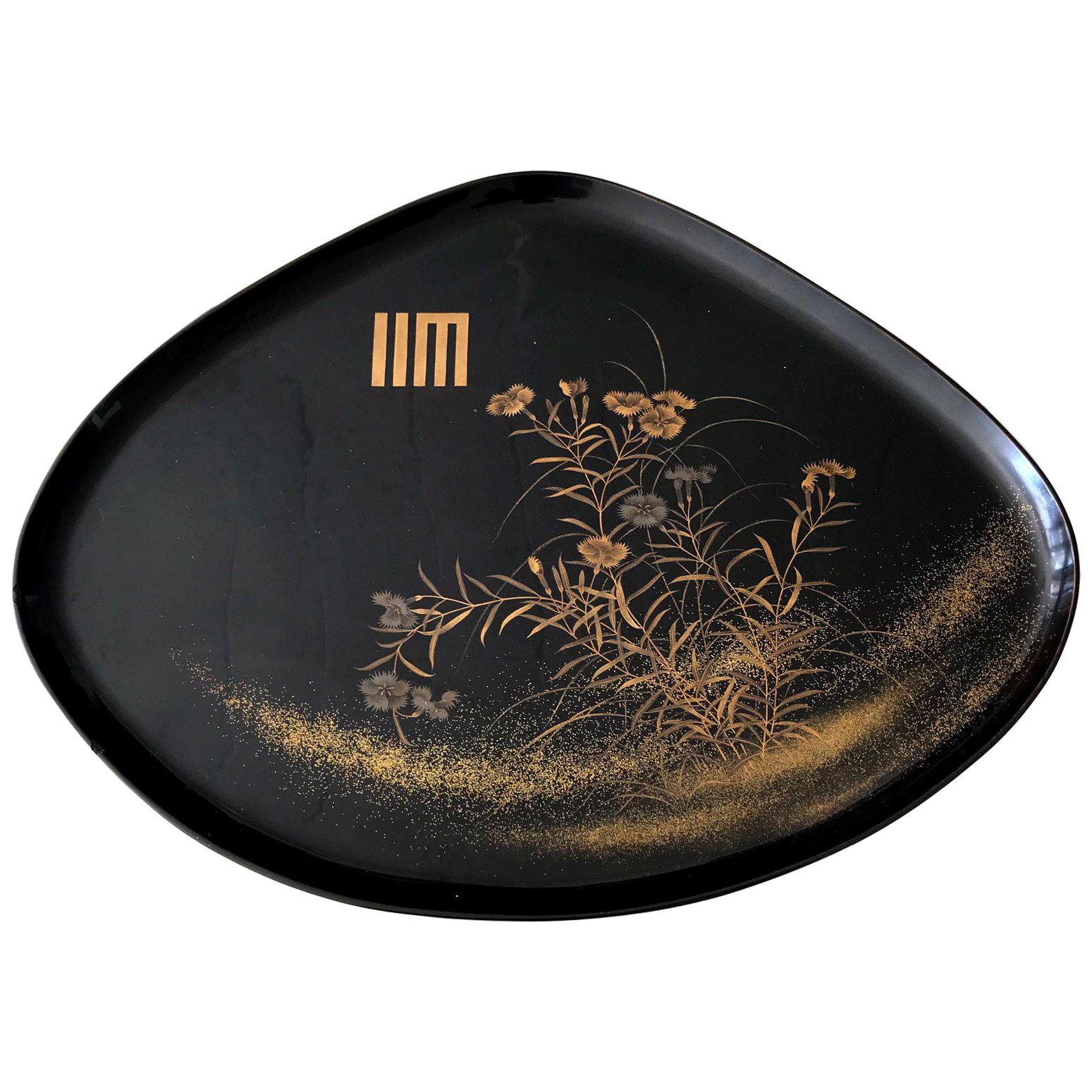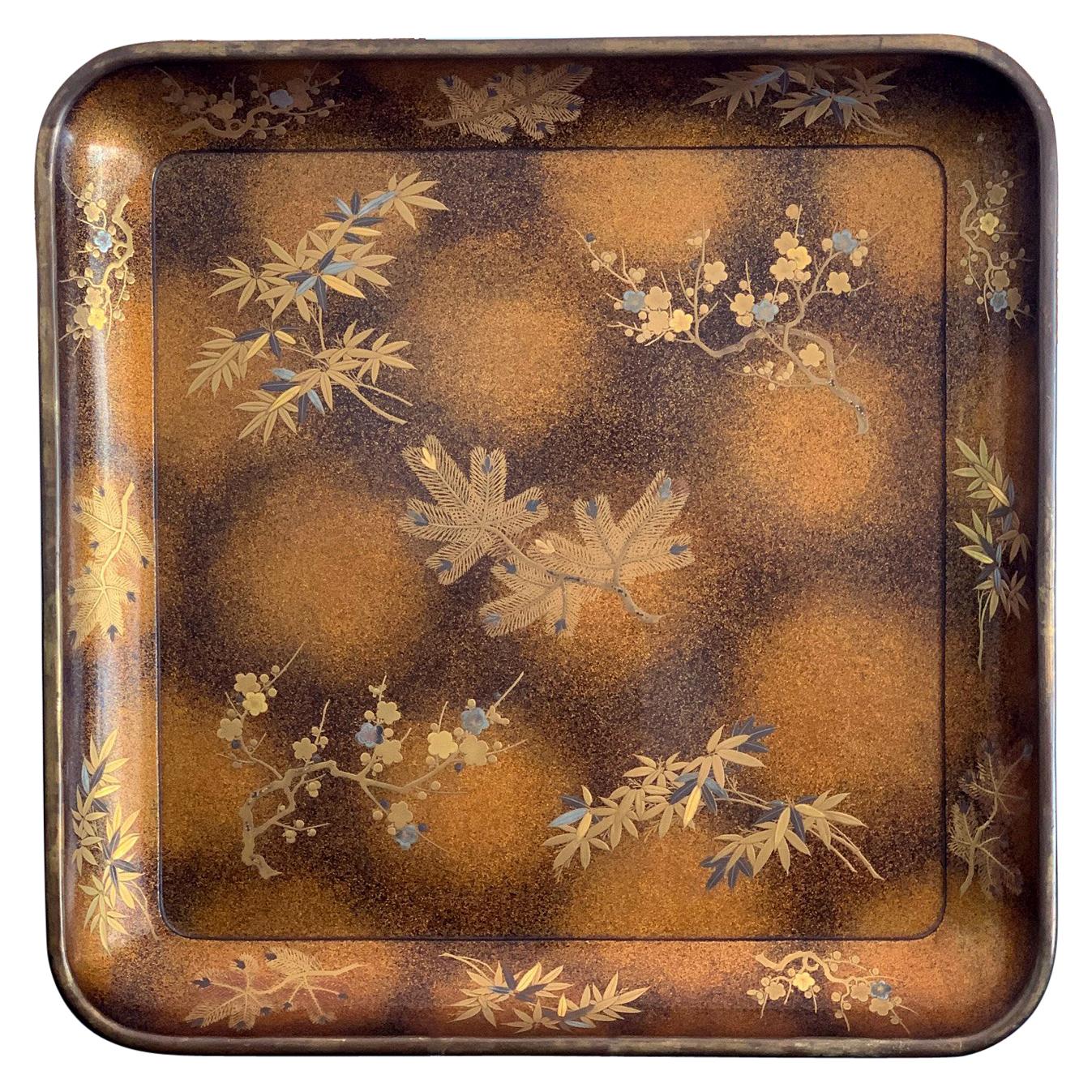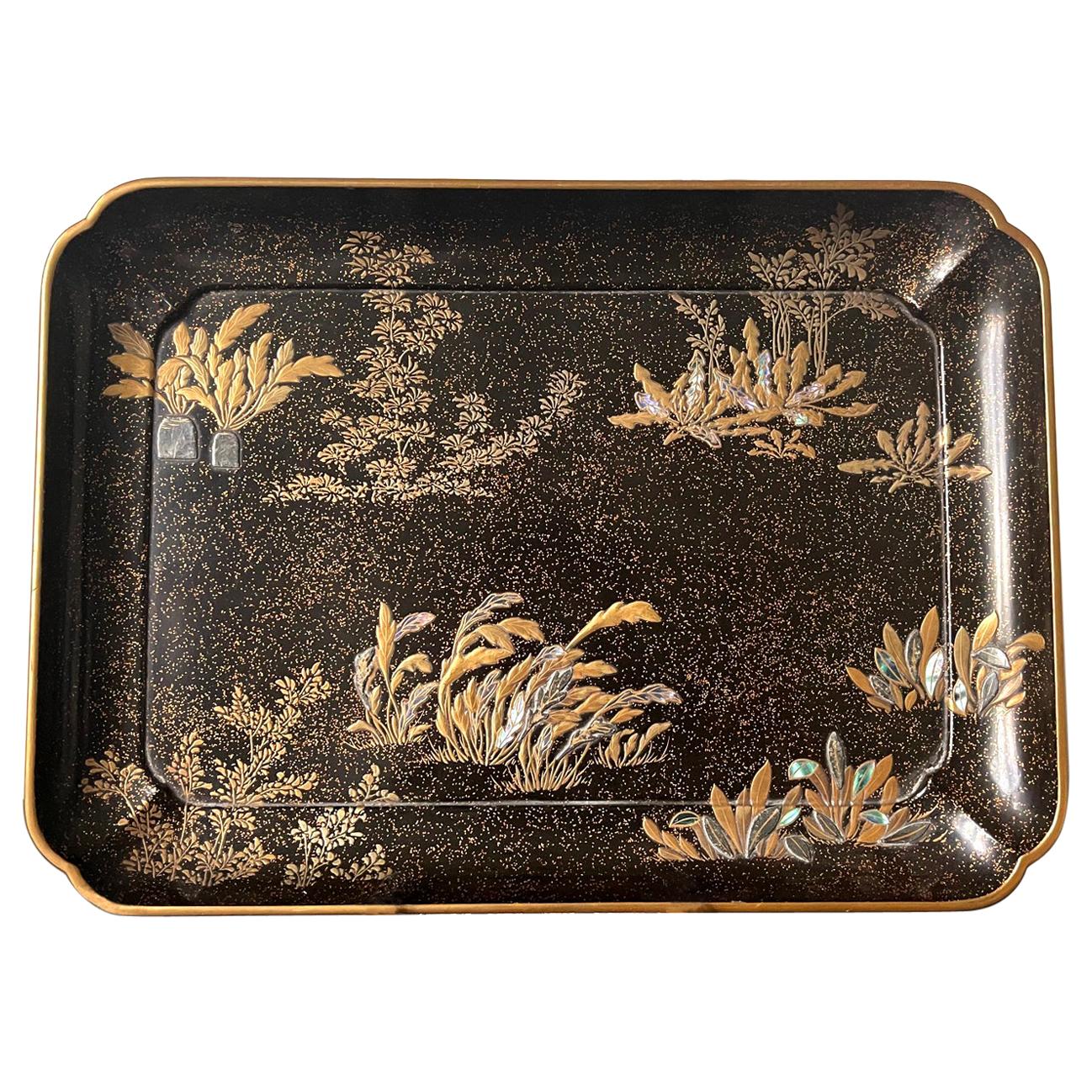Items Similar to Japanese Red and Black Lacquer Maki-e Decorated Presentation Tray, dated 1917
Want more images or videos?
Request additional images or videos from the seller
1 of 11
Japanese Red and Black Lacquer Maki-e Decorated Presentation Tray, dated 1917
About the Item
A fine Japanese red and black maki-e lacquer presentation tray with original tomobako storage box, Taisho period, dated 1917, Japan.
The large presentation tray set on cabriole legs and decorated with maki-e (gold dust) designs of various stylized mon (family crests) including phoenix, chrysanthemum, butterfly, and deer, all upon a black lacquer ground. The interior of the tray a brilliant vermillion red lacquer, contrasting nicely with the black and gold.
Comes with the original inscribed wood storage box, dated Taisho Year 6, corresponding to 1917.
- Dimensions:Height: 9 in (22.86 cm)Width: 28 in (71.12 cm)Depth: 22 in (55.88 cm)
- Style:Taisho (Of the Period)
- Materials and Techniques:
- Place of Origin:
- Period:1910-1919
- Date of Manufacture:1917
- Condition:Wear consistent with age and use. Minor structural damages. One interior corner with slight separation, as seen in photos. The same corner, the leg with a slight gouge, as seen in photos.
- Seller Location:Austin, TX
- Reference Number:1stDibs: LU89478464453
About the Seller
5.0
Platinum Seller
These expertly vetted sellers are 1stDibs' most experienced sellers and are rated highest by our customers.
Established in 2001
1stDibs seller since 2010
305 sales on 1stDibs
Typical response time: 1 hour
- ShippingRetrieving quote...Ships From: Austin, TX
- Return PolicyA return for this item may be initiated within 7 days of delivery.
More From This SellerView All
- Japanese Lacquer Display Cabinet on Stand, Meiji Period, 19th Century, JapanLocated in Austin, TXA spectacular Japanese lacquer and porcelain inlaid display cabinet on stand, kazaridana, Meiji Period, late 19th century, Japan. The sumptuous kazaridana of traditional display cabinet form, with several shelves and enclosed spaces for display and storage. The cabinet decorated all over in beautiful maki-e lacquer against a dense nashiji ground and inset with blue and white Arita porcelain plaques. The front of the cabinet of asymmetric design, with two open display shelves at staggered heights, and several doors enclosing storage areas of various shapes and sizes, including one hinged corner door, two pairs of sliding doors, and one pair of hinged doors opening to reveal a rounded inset corner shelf. A pair of drawers below complete the cabinet. All supported on a separate tall fitted stand. The corner door decorated with a bold scene of a samurai warrior fighting a demon. This most likely depicts the warrior Watanabe no Tsuna battling the demon Ibaraki-doji at Rashomon gate, in which Watanabe no Tsuna attempts to help a young girl return home, carrying her on his back, only for the girl to turn into a demon, which he then must fight. The top pair of sliding doors with a scene of a man playing the sho, a Japanese mouth organ, along the banks of a river with a waterfall in the background. The bottom pair of sliding doors with a waterfall scene on one side, while a scholar lounges with his attendants on the other. The pair of hinged doors finely decorated with a pair of fully armored samurai. The two drawers wonderfully decorated in the kodaiji style with a stream of rushing water and various plants and grasses. The cabinet is decorated in the round, with the top, sides, and base of the cabinet decorated with various scenes of flowers and birds, and inset with blue and white Arita porcelain plaques in the form of traditional fan. The fans painted...Category
Antique 1880s Japanese Meiji Lacquer
MaterialsPorcelain, Softwood, Lacquer
- Japanese Maki-e Lacquer Stacking Box, Jubako, Meiji Period, JapanLocated in Austin, TXA fine and impressive Japanese gold maki-e decorated black lacquer five-tier jubako with presentation tray, two lids, and the original tomobako storage box, Meiji period, late 19th c...Category
Antique Late 19th Century Japanese Meiji Lacquer
MaterialsLacquer
- Large Japanese Marquetry Table Cabinet, Meiji Period, Late 19th Century, JapanLocated in Austin, TXA fine and unusually large Japanese table cabinet or jewelry chest with yosegi marquetry work and lacquer paneled doors, Meiji period, late 19th century, Japan. The oversized tab...Category
Antique 1890s Japanese Meiji Furniture
MaterialsBrass
- Japanese Maki-e Lacquer Document Box, Edo Period, early 19th Century, JapanLocated in Austin, TXA spectacular Japanese maki-e lacquer lidded box, possibly a writing box, suzuribako, decorated with images of folding fans, ogi, Edo Period, earl...Category
Antique Early 19th Century Japanese Edo Lacquer
MaterialsCoral
- Japanese Orange Red Negoro Lacquer Low Table, Taisho Period, 1920s, JapanLocated in Austin, TXA striking orange-red lacquer Japanese low tea or coffee table decorated in the negoro lacquer technique, Taisho period, 1920s, Japan. Of simplistic design, the table has a wonder...Category
Vintage 1920s Japanese Taisho Coffee and Cocktail Tables
MaterialsSoftwood, Lacquer
- Large Japanese Black Lacquer Dowry Trunk, NagamochiLocated in Austin, TXMade for a member of the Japanese Imperial Family, as indicated by the sixteen petal chrysanthemum which appears in several elements of the relief carved shakudo and gold metal work on the trunk. The raised lacquer imperial chrysanthemum seal, of which only abstracted remnants remain, was probably intentionally abraded when this particular branch of the family was divested of its title during the American Occupation of 1947. Of unusually generous proportions, with a slightly domed lid. Large handles on the side were used for carrying the the bridal trousseau. The hinges are constructed in such a way that the lid can be slid off after opening, for easier access. Provenance: The estate of Ann Landers...Category
Antique Late 19th Century Japanese Meiji Trunks and Luggage
MaterialsLacquer
You May Also Like
- Japanese Maki-e Lacquer Tray Box with Cutout DesignLocated in Atlanta, GAA Japanese lacquer box with lid and an inner tray decorated with Maki-e on a dense nashiji background. The fine box was likely made circa 1920-30s during the Tashio period and likely...Category
Vintage 1920s Japanese Taisho Lacquer
MaterialsWood, Lacquer
- An Antique Japanese Lacquer Maki-e TrayLocated in Atlanta, GAA fan shape black lacquer tray from Japan circa 1910-30s, late Meiji to early Showa era. Elaborated decorated with a bundle of yomogi blossom in a very fine Maki-e technique using both gold and silver powders. There is a Japanese symbol on the top left, which represents yomogiu, stemming from yomogi (蓬), a wild plant that belongs to the chrysanthemum family and widely grown in Japan. This name yomogui is from a scene in the Tale of Genji...Category
Early 20th Century Japanese Japonisme Lacquer
MaterialsLacquer
- Early 20th Century, Showa, a Pair of Japanese Lacquered TraysLocated in Sampantawong, THA pair of Japanese serving lacquered trays. Age: Japan, Showa Period, Early 20th Century Size: height 20.5 cm / width 38 cm / length 69 cm. Condition: Nice condition overall. ...Category
Early 20th Century Japanese Furniture
MaterialsWood
- Large Vintage Japanese Maki-e Lacquer Kimono TrayLocated in Atlanta, GAA large square lacquer presentation tray (likely for kimono) predated 1950 of the Showa period. Elaborately decorated with Maki-e that depicts the prunus blossom, bamboo and needle p...Category
Vintage 1940s Japanese Japonisme Lacquer
MaterialsWood, Lacquer
- A Japanese maki-è lacquer inroLocated in Milano, ITJapanese inro with two compartments, in maki-è lacquer with nashiji decorations and circular reserves depicting flowers and leaves. Coral colored ojime and lacquer manju netsuke. Si...Category
Antique Mid-19th Century Japanese Japonisme Lacquer
MaterialsLacquer
- Japanese Lacquer Tray with Maki-e and Inlay Hara Yoyusai Edo PeriodLocated in Atlanta, GAA lovely Japanese lacquer rectangular lacquer tray with a slightly scalloped corner and four L shape supporting feet by one of the most celebrated lacquer artist active in Edo period Hara Yoyusai (1772-1845). Yoyusai lived in Edo (Tokyo) and worked under the patronage of Lord Matsudaira. He operated a large workshop and had a very prolific output of lacquer objects. Most survived pieces being inro...Category
Antique 19th Century Japanese Japonisme Lacquer
MaterialsWood, Lacquer
Recently Viewed
View AllMore Ways To Browse
Antique Japanese Wedding Box
Bento Box Vintage
Sofu Teshigahara
Vintage Wooden Paper Tray
Golden Toad
Japanese Antique Bento
Japanese Ojime
Lac Burgaute
Vintage Japanese Bento Box
Antique Quran Stand
Japanese Tanzaku
Stacking Lunch Box
Suzuki Silver
Burmese Lacquerware Betel Box
Chinese Chippendale Jewelry Box
Japanese Bone Inro
Lacquer Hsunok
Japanese Bento





